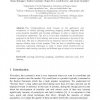Free Online Productivity Tools
i2Speak
i2Symbol
i2OCR
iTex2Img
iWeb2Print
iWeb2Shot
i2Type
iPdf2Split
iPdf2Merge
i2Bopomofo
i2Arabic
i2Style
i2Image
i2PDF
iLatex2Rtf
Sci2ools
KES
2007
Springer
2007
Springer
Automated Ham Quality Classification Using Ensemble Unsupervised Mapping Models
This multidisciplinary study focuses on the application and comparison of several topology preserving mapping models upgraded with some classifier ensemble and boosting techniques in order to improve those visualization capabilities. The aim is to test their suitability for classification purposes in the field of food industry and more in particular in the case of dry cured ham. The data is obtained from an electronic device able to emulate a sensory olfative taste of ham samples. Then the data is classified using the previously mentioned techniques in order to detect which batches have an anomalous smelt (acidity, rancidity and different type of taints) in an automated way.
| Added | 08 Jun 2010 |
| Updated | 08 Jun 2010 |
| Type | Conference |
| Year | 2007 |
| Where | KES |
| Authors | Bruno Baruque, Emilio Corchado, Hujun Yin, Jordi Rovira, Javier González |
Comments (0)

